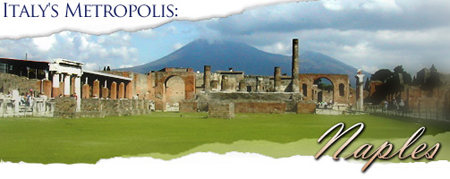|

Naples,
Italy - A Holland America Port
Naples,
Italy is just one of the rich cities
scheduled during the Holland America
10-Day Mediterranean Cruise. The highly-populated
metropolitan area offers visitors not
only a look at its precious European
history, but the latest in shopping,
entertainment and cuisine.
What
to See
The relaxed Neapolitan attitude belies
this city's importance, but those who
take time to investigate the quiet refuge
of its many churches and old neighborhoods
are well rewarded. Start your tour at
the imposing Castel Nuovo, whose Aragonese
structure dates back to 1282, and is
a copy of the famous structure at Angers.
Its Capella Palatina is a repository
for a collection of noted paintings
by artist Laurana. Just beyond this
castle, the Palazzo Reale displays its
17th-Century construction as you pass
through nearby Porto di Santa Lucia
Mergellina on your way to charming Santa
Luca.
Leaving the waterfront at the port,
you can head towards the central Duomo,
dedicated to the city's patron San Gennaro
in the 13th Century. A strange tradition
surrounds this saint, who was martyred
for his Christian belief in 305 A.D.
during Emperor Diocletian's notorious
purge. The saint's body was than transferred
to Naples along with two vials of his
dried blood. It's said the saint's blood
will liquefy upon human touch, and this
miracle is repeated three times a year
for devout Neapolitans who flood the
city's cathedral. During a special mass,
a vial of dried blood is produced and
after much prayer, the miracle is said
to happen. People pack the cathedral
during December, May and September for
one of the city's most important ceremonies.
If the blood refuses to liquefy, superstitious
followers believe disaster will strike
Naples.
Down the street from the church, toward
the harbor, a collection at Museo Filangieri
showcases works by Jose Ribera and Luca
Giordano. The small museum is the 15th-Century
Palazzo Cuomo, and its collection represents
the private gallery of former owner
Prince Filangieri. The works were stowed
away during World War II and returned
soon after the war. Between the Duomo
and the museum, Capella del Pio Monte
della Misericorda is home to one of
the city's most treasured canvases -
Caravaggio's "Seven Works of Mercy."
The old city's picturesque central district,
known as Spaccanapoli (the Naples divide),
is home to many city churches. While
the 14th-Century Gothic San Lorenzo
Maggiore is remarkable enough, the archaeological
site below it is stunning. Built atop
Naples' ancient central road Decamanus
Maximus, the church is a gateway to
5th Century B.C.
According to some, Naples' finest collection
is the Museo Archeologico Nazionale,
a showcase of ancient finds from Campania
and neighboring Lazio. There are mosaics,
ancient sculptures and many relics from
Pompeii and Herculaneum. Up the street,
the city's famous catacombs are accessible
inside San Gennaro and San Gaudioso.
Travel to the ruins of Pompeii and you'll
see, where in 79 A.D., Mount Vesuvius
shook the ground as far north as Milan,
instantly ruining many Roman villages.
Violent earthquakes had signaled the
impending volcanic eruption for more
than a decade, but many residents refused
to leave their elegant homes.
The ancient site is remarkably similar
to modern-day cities. A mosaic at the
entrance to one Pompeii home, for example,
eerily warns all its visitors to "Beware
of the Dog."
History
Campania is the official welcome city
for Italy's culturally rich south. Naples
is generous with its riches - the lavish
pier features a marble terminal building
- but just beyond the shadow of the
sleek, high-rise financial towers, tradition
thrives. There are suburban fishing
villages, and even the bustling capital
of Naples retains the atmosphere of
a charming small town; perhaps a reflection
of the fact that the city is really
a conglomerate of small communities.
Romans have always viewed the region
with admiration. The relaxed pace of
Naples life is surprisingly pleasant
given the city's size and industrial
nature. While nearly every aspect of
Campania life is connected to the massive
city and its workings.
Read
more about the Holland
America Line Mediterranean Cruise.
|